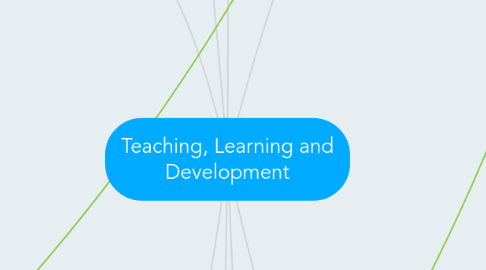
1. Week 5: Assessing Student Progress
1.1. Types of Assessment
1.1.1. Diagnostic
1.1.1.1. Pre-Established Knowledge
1.1.2. Formative
1.1.2.1. Refine and Modify all aspects of teaching
1.1.2.2. Allows for teachers to check understanding
1.1.3. Summative
1.1.3.1. How well students have learned the material
1.2. Assessment Design Process
1.2.1. Designing Questions
1.2.2. Types of Assessment Questions
1.2.2.1. selected-response questions
1.2.2.2. constructed-response
1.2.2.3. Assessment Questions according to Bloom's Taxonomy
1.2.3. Designing Tests and Exams
1.2.4. Selected-Response Questions
1.2.4.1. True/False questions
1.2.4.1.1. Easiest question for students to guess
1.2.4.2. Matching questions
1.2.4.3. Multiple-choice questions
1.2.5. Constructed -Response Questions
1.2.5.1. Short-answer questions
1.2.5.2. Restricted-essay and essay questions
1.2.5.2.1. rubric
1.2.6. Authentic Tools
1.2.6.1. Authentic Assessment
1.2.6.2. Portfolio
1.2.7. How People Learn Framework by Theresa Nelson
2. Week 6: Individual Differences- Intellectual Abilities and Challenges
2.1. Intelligence
2.1.1. Carroll's Hierarchical Model of Intelligence
2.1.1.1. Fluid intelligence
2.1.1.2. Visual-Spatial reasoning
2.1.1.3. Crystallized Intelligence
2.1.2. Intelligence as Structures
2.1.2.1. Gardner's (1983) Multiple Intelligence Theory
2.1.3. Intelligence as Processes
2.1.3.1. Sternberg's (1985) Triarchic Theory Of Intelligence
2.1.3.1.1. Analytical/Componential Intelligence
2.1.3.1.2. Creative/Experimental Intelligence
2.1.3.1.3. Practical/Contextual Intelligence
2.2. Special Education
2.2.1. Specialized Instruction
2.2.1.1. High-incidence exceptionalities
2.2.1.1.1. Giftedness
2.2.1.2. Low-incidence exceptionalities
2.2.1.2.1. Students with Autism
2.2.2. Inclusion
2.2.3. Individualized Education Program (IEP)
2.2.3.1. Psycho-educational assessment
2.2.3.2. The Six Phases of the Assessment and IEP Process
2.2.4. Cognitive Abilities of Students with Exceptionalities
2.2.4.1. Differentiated Learning
2.2.4.1.1. Ken Robinson's
2.2.5. Students with ADHD
2.2.5.1. What Works? Research Into Practice
3. Week 7: Sociocultural Considerations
3.1. Socio-cultural Perspectives
3.1.1. Differences wth Identified Groups
3.1.2. Critical Consciousness of Teachers
3.1.2.1. Critical Consciousness
3.1.3. Stereotype Threat and Socio-economic Status
3.1.3.1. stereotype threat
3.1.3.2. prejudice
3.1.3.3. SES
3.1.3.3.1. Parenting Style
3.1.4. Multicultural Education
3.1.4.1. Different Views
3.1.4.2. Bank's Model
3.1.4.3. HOW DO WE KNOW WE ARE MAKING A DIFFERENCE?
3.1.4.4. The Danger of a Single Story
3.1.5. Aboriginal Education
3.1.5.1. Prospective Factors
3.1.5.2. Fostering Literacy Success for First Nations, Métis and Inuit Students
4. Week 8: Standardized Achievement Tests
4.1. Testing Issues
4.1.1. Standardized Testing
4.1.2. Achievement versus Aptitude Tests
4.1.2.1. Attitude Test
4.1.2.2. Criterion-referenced Test
4.1.2.3. Norm-references Test
4.1.3. Misconceptions
4.1.3.1. The Purpose, Outcomes and Future of Standardized Testing
4.2. Constructing Better Standardized Tests
4.2.1. Five Essential Elements
4.3. Connections between Classroom Curricula and Standardized Tests
4.4. Preparing Students for Test-Writing
4.5. Interpreting Test Results
4.6. Canadian Standards for Standardized Achievement Testing
4.6.1. EQAO
4.6.2. Literacy Test
5. Week 1: Planning for the Upcoming School Year
5.1. Reflective Practice: teacher who chooses to analyze and reflect on his/her practice to asses the effects of his/her teaching in order to become a more effective educator
5.2. Curriculum Planning
5.2.1. Top-down approach
5.2.1.1. Year-long
5.2.1.2. Unit
5.2.1.3. Daily
5.2.2. Educational Purpose
5.2.3. Learning Experiences
5.2.4. Evaluation
5.3. Instructional Planning
5.3.1. Constructivism
5.4. Sschwab's (1973) Commonplaces of Education
5.4.1. teacher
5.4.2. curriculum
5.4.3. student
5.4.4. classroom
6. Week 2: Considering Developmental Differences
6.1. Developmental Influences
6.1.1. Physical Abilities
6.1.1.1. Predetermined Path
6.1.1.2. It takes about 20 years for the prefrontal cortex to become fully functional
6.1.2. Cognitive Abilities
6.1.2.1. Executive Cognitive Functioning
6.1.2.2. Innate Curiosity
6.1.2.2.1. What Adults Can Learn from Kids
6.1.2.3. Innate Drive to Organize
6.1.2.3.1. schemas
6.1.2.4. Innate Drive to Adjust
6.1.2.4.1. adaptation
6.1.2.4.2. assimilation
6.1.2.4.3. accommodation
6.1.2.5. Piaget's Four Stages of Cognitive Development
6.1.2.5.1. Sensorimotor
6.1.2.5.2. Pre operational
6.1.2.5.3. Concrete Operations
6.1.2.5.4. Formal Operations
6.1.2.6. Domain Specific Learning
6.1.2.6.1. Zone of proximal development
6.1.2.6.2. Scaffolding
6.1.2.7. Language Development
6.1.2.7.1. Language-Acquisition Device (LAD)
6.1.2.8. Growth Mindset
6.1.2.8.1. Carol Dweck
6.1.3. Social Abilities
6.1.3.1. Personal and Social Development
6.1.3.1.1. Making Choices
6.1.3.1.2. Self
6.1.3.1.3. Self-Concept and Self-Esteem
6.1.3.2. Ecological Theory
6.1.3.2.1. Bronfenbrenner's
6.2. Principles of Development
6.2.1. Orderly and Logical Progression
6.2.2. Gradually Progressive Process
6.2.3. Quantitative and Qualitative Changes
6.2.4. Develop at different rates
6.2.5. Genetics and Environment
7. Week 3: Establishing a Positive Learning Environment
7.1. Classroom Management
7.1.1. Process-outcome research
7.1.2. Dynamic Classroom Management
7.1.2.1. Positive Behaviour Support
7.1.2.2. Classroom Discourse Research
7.1.3. Teacher Behaviours that Diminish Student Behaviour Problems
7.1.3.1. Positive Feedback to Students
7.1.3.2. Sustained Feedback to Students
7.1.3.3. Respond supportively to students
7.1.3.4. Ask questions that students are able to answer correctly
7.1.3.5. Present learning tasks for which students have a high probability of success
7.1.3.6. Use time efficiently
7.1.3.7. Keep the need for disciplinary low through positive classroom management
7.1.3.7.1. Getting Curious (Not Furious) With Students
7.1.3.8. Keep off-task time to a minimum
7.1.3.9. Ten Tips For Classroom Management
7.1.4. ADHD
7.1.5. Resiliency
7.1.5.1. Good self-esteem Sense of competence Optimistic Personal control Feel connected Motivated to learn Self-disciplined
8. Week 4: Making Instructional Differences
8.1. Learning Objectives and Lesson Plans
8.1.1. Backward Design
8.1.1.1. Overall Learning Objectives
8.1.1.1.1. Specific Learning Objectives
8.1.2. Bloom's Taxonomy
8.1.2.1. Knowledge
8.1.2.2. Comprehension
8.1.2.3. Application
8.1.2.4. Analysis
8.1.2.5. Synthesis
8.1.2.6. Evaluation
8.1.3. Stiggin's Achievement Targets
8.1.3.1. Knowledge
8.1.3.2. Reasoning
8.1.3.3. Skills
8.1.3.4. Products
8.1.3.5. Attitudes and Dispositions
8.2. Diagnostic Assessment
8.3. My Instructional Practices
8.3.1. Universal Instructional Design (UID)
8.3.2. Cognitive Strategies
8.3.3. Select-Organize-Integrate
8.3.4. Motivational Underpinnings
8.3.4.1. Tasks
8.3.4.2. Classroom Relationships
8.3.4.2.1. Intrinsic Motivation
8.3.4.2.2. Extrinsic Motivation
8.3.5. Direct Instruction (DI)
8.3.5.1. well-developed and carefully planned lessons with clear learning objectives that are purposefully presented to students
8.3.6. Student Problem Solving
8.3.6.1. Verbal Protocol Analysis
8.3.6.2. Problem, Project and Inquiry Based Learning
8.3.6.2.1. Inquiry Based Learning
8.3.6.3. Constructivism
